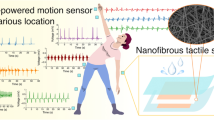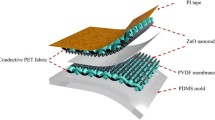Abstract
Flexible wearable sensors with excellent electric response and self-powered capability have become an appealing hotspot for personal healthcare and human—machine interfaces. Here, based on triboelectric nanogenerator (TENG), a flexible self-powered tactile sensor composed of micro-frustum-arrays-structured polydimethylsiloxane (PDMS) film/copper (Cu) electrodes, and poly(vinylidenefluoride—trifluoroethylene) (P(VDF-TrFE)) nanofibers has been demonstrated. The TENG-based self-powered tactile sensor can generate electrical signals through the contact-separation process of two triboelectric layers under external mechanical stimuli. Due to the uniform and controllable micro-frustum-arrays structure fabricated by micro-electro-mechanical system (MEMS) process and the P(VDF-TrFE) nanofibers fabricated by electrostatic spinning, the flexible PDMS-based sensor presents high sensitivity of 2.97 V kPa−1, stability of 40,000 cycles (no significant decay), response time of 60 ms at 1 Hz, low detection pressure of a water drop (∼4 Pa, 35 mg) and good linearity of 0.99231 in low pressure region. Since the PDMS film presents ultra-flexibility and excellent-biocompatibility, the sensor can be comfortably attached on human body. Furthermore, the tactile sensor can recognize various types of human body movements by the corresponding electrical signals. Therefore, the as-prepared TENGs are potential on the prospects of gesture detection, health assessment, human-machine interfaces and so on.
摘要
具有出色电学响应和自供电能力的柔性可穿戴传感器已成为个人医疗保健和人机交互领域重要的研究方向. 本文制备了一种基于摩擦纳米发电机的柔性自供电触觉传感器, 由具有微四棱锥台结构的PDMS薄膜、铜电极以及P(VDF-TrFE)纳米纤维组成. 在外部机械力刺激下, 该传感器能通过接触-分离模式直接产生电学信号. MEMS工艺制备的均匀可控的微四棱锥台结构和静电纺丝制备的P(VDF-TrFE)纳米纤维, 使得传感器展现出高灵敏度(2.97 V kPa−1), 高稳定性(超过40000次循环没有衰减) 、快速响应(在1 Hz频率下60 ms)、低压力探测能力(重约35 mg, 压强约为4 Pa的水滴)以及良好的线性度(在低压力区域为0.99231). PDMS薄膜的超柔韧性和优异的生物相容性, 使得传感器能舒适地贴合在人体皮肤上. 此外, 所设计的传感器可以通过判断对应的电学响应信号识别各种人体运动类型. 基于上述优势, 该摩擦纳米发电机有望应用于姿态监测、健康评估以及人机交互等领域.
Similar content being viewed by others
References
Tee BCK, Chortos A, Berndt A, et al. A skin-inspired organic digital mechanoreceptor. Science, 2015, 350: 313–316
Kim DH, Lu N, Ghaffari R, et al. Materials for multifunctional balloon catheters with capabilities in cardiac electrophysiological mapping and ablation therapy. Nat Mater, 2011, 10: 316–323
Son D, Lee J, Qiao S, et al. Multifunctional wearable devices for diagnosis and therapy of movement disorders. Nat Nanotech, 2014, 9: 397–404
Viventi J, Kim DH, Vigeland L, et al. Flexible, foldable, actively multiplexed, high-density electrode array for mapping brain activity in vivo. Nat Neurosci, 2011, 14: 1599–1605
Webb RC, Bonifas AP, Behnaz A, et al. Ultrathin conformal devices for precise and continuous thermal characterization of human skin. Nat Mater, 2013, 12: 938–944
Chen S, Lou Z, Chen D, et al. Highly flexible strain sensor based on ZnO nanowires and P(VDF-TrFE) fibers for wearable electronic device. Sci China Mater, 2016, 59: 173–181
Deng W, Yang T, Jin L, et al. Cowpea-structured PVDF/ZnO nanofibers based flexible self-powered piezoelectric bending motion sensor towards remote control of gestures. Nano Energy, 2019, 55: 516–525
Wang C, Hwang D, Yu Z, et al. User-interactive electronic skin for instantaneous pressure visualization. Nat Mater, 2013, 12: 899–904
Shi R, Lou Z, Chen S, et al. Flexible and transparent capacitive pressure sensor with patterned microstructured composite rubber dielectric for wearable touch keyboard application. Sci China Mater, 2018, 61: 1587–1595
Zhang Z, Yang J, He X, et al. Plasmonic refractive index sensor with high figure of merit based on concentric-rings resonator. Sensors, 2018, 18: 116
Maeda Y, Terao K, Shimokawa F, et al. Reduction of contact force dependence on the mems hardness sensor using reference plane to detect human body hardness. 2015 IEEE Sensors, 2015, 15717259
Cao Y, Li T, Gu Y, et al. Fingerprint-inspired flexible tactile sensor for accurately discerning surface texture. Small, 2018, 14: 1703902
Lee BY, Kim SU, Kang S, et al. Transparent and flexible high power triboelectric nanogenerator with metallic nanowire-embedded tri-bonegative conducting polymer. Nano Energy, 2018, 53: 152–159
Song Z, Li W, Bao Y, et al. Breathable and skin-mountable strain sensor with tunable stretchability, sensitivity, and linearity via surface strain delocalization for versatile skin activities’ recognition. ACS Appl Mater Interfaces, 2018, 10: 42826–42836
Choi MK, Park OK, Choi C, et al. Cephalopod-inspired miniaturized suction cups for smart medical skin. Adv Healthcare Mater, 2016, 5: 80–87
Chen X, Parida K, Wang J, et al. A stretchable and transparent nanocomposite nanogenerator for self-powered physiological monitoring. ACS Appl Mater Interfaces, 2017, 9: 42200–42209
Jian M, Xia K, Wang Q, et al. Flexible and highly sensitive pressure sensors based on bionic hierarchical structures. Adv Funct Mater, 2017, 27: 1606066
Wang X, Gu Y, Xiong Z, et al. Silk-molded flexible, ultrasensitive, and highly stable electronic skin for monitoring human physiological signals. Adv Mater, 2014, 26: 1336–1342
Choong CL, Shim MB, Lee BS, et al. Highly stretchable resistive pressure sensors using a conductive elastomeric composite on a micropyramid array. Adv Mater, 2014, 26: 3451–3458
Lin L, Xie Y, Wang S, et al. Triboelectric active sensor array for self-powered static and dynamic pressure detection and tactile imaging. ACS Nano, 2013, 7: 8266–8274
Chen Z, Wang Z, Li X, et al. Flexible piezoelectric-induced pressure sensors for static measurements based on nanowires/graphene heterostructures. ACS Nano, 2017, 11: 4507–4513
Park DY, Joe DJ, Kim DH, et al. Self-powered real-time arterial pulse monitoring using ultrathin epidermal piezoelectric sensors. Adv Mater, 2017, 29: 1702308
Chen SW, Cao X, Wang N, et al. An ultrathin flexible single-electrode triboelectric-nanogenerator for mechanical energy harvesting and instantaneous force sensing. Adv Energy Mater, 2017, 7: 1601255
Ouyang H, Tian J, Sun G, et al. Self-powered pulse sensor for antidiastole of cardiovascular disease. Adv Mater, 2017, 29: 1703456
Jung JH, Lee M, Hong JI, et al. Lead-free NaNbO3 nanowires for a high output piezoelectric nanogenerator. ACS Nano, 2011, 5: 10041–10046
Wang S, Lin L, Wang ZL. Triboelectric nanogenerators as self-powered active sensors. Nano Energy, 2015, 11: 436–462
Wen Z, Guo H, Zi Y, et al. Harvesting broad frequency band blue energy by a triboelectric-electromagnetic hybrid nanogenerator. ACS Nano, 2016, 10: 6526–6534
Guo Y, Zhang XS, Wang Y, et al. All-fiber hybrid piezoelectric-enhanced triboelectric nanogenerator for wearable gesture monitoring. Nano Energy, 2018, 48: 152–160
Cheng X, Meng B, Chen X, et al. Single-step fluorocarbon plasma treatment-induced wrinkle structure for high-performance tribo-electric nanogenerator. Small, 2016, 12: 229–236
Niu S, Wang ZL. Theoretical systems of triboelectric nanogenerators. Nano Energy, 2015, 14: 161–192
Fan FR, Lin L, Zhu G, et al. Transparent triboelectric nanogenerators and self-powered pressure sensors based on micropatterned plastic films. Nano Lett, 2012, 12: 3109–3114
Li Z, Wang ZL. Air/liquid-pressure and heartbeat-driven flexible fiber nanogenerators as a micro/nano-power source or diagnostic sensor. Adv Mater, 2011, 23: 84–89
Wang ZL. Self-powered nanosensors and nanosystems. Adv Mater, 2012, 24: 280–285
Lim S, Son D, Kim J, et al. Transparent and stretchable interactive human machine interface based on patterned graphene hetero-structures. Adv Funct Mater, 2015, 25: 375–383
Acknowledgements
This work was financially supported by the National Natural Science Foundation of China (51605449, 51675493 and 51705476), the National Key R&D Program of China (2018YFF0300605), Shanxi “1331 Project” Key Subject Construction (1331KSC), the Applied Fundamental Research Program of Shanxi Province (201601D021070) and Zhangjiakou Science and Technology Research and Development Plan of Zhangjiakou City (1811009B-10).
Author information
Authors and Affiliations
Contributions
Author contributions Yu J and Hou X designed the devices and experiments; Yu J, Hou X, Cui M and He J performed the experiments; Yu J, Shi S, Sun Y and Wang C analyzed the data; Yu J wrote the paper with support from Hou X and Chou X. All authors contributed to the general discussion. Yu J and Hou X contributed equally to this work.
Corresponding author
Additional information
Conflict of interest The authors declare no conflict of interest.
Junbin Yu obtained his BSc degree in 2015 from Tianjin University of Technology and Education. Currently he is a PhD student at the Science and Technology on Electronic Test and Measurement Laboratory in the North University of China (NUC). His main research topic is energy harvesting and flexible self-powered sensor system.
Xiujian Chou works at the School of Instrument and Electronics of the NUC. He received his PhD degree majored in material physics and chemistry at Tongji University in 2008. Currently he is engaged in intelligent micro/nano device and micro system.
Electronic supplementary material
Rights and permissions
About this article
Cite this article
Yu, J., Hou, X., Cui, M. et al. Flexible PDMS-based triboelectric nanogenerator for instantaneous force sensing and human joint movement monitoring. Sci. China Mater. 62, 1423–1432 (2019). https://doi.org/10.1007/s40843-019-9446-1
Received:
Accepted:
Published:
Issue Date:
DOI: https://doi.org/10.1007/s40843-019-9446-1




